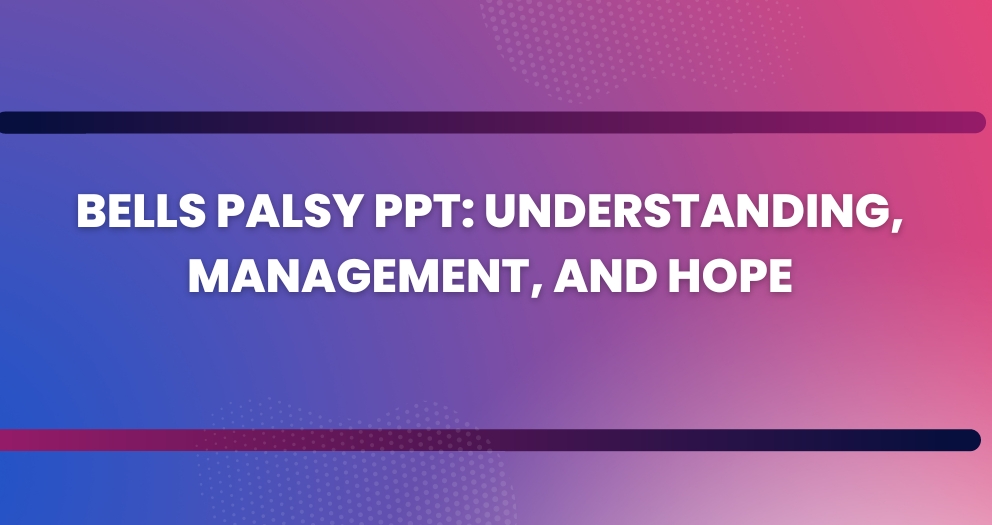Bells Palsy PPT: Understanding, Management, and Hope
Introduction
Bells Palsy PPT, often referred to as Bell’s Palsy, is a medical condition that can be challenging to navigate. In this comprehensive guide, we will explore every aspect of Bells Palsy PPT, shedding light on its causes, symptoms, treatment options, and the hope that comes with understanding and managing this condition. Whether you or a loved one are facing Bells Palsy PPT, or you’re simply curious to learn more, this article is your informative companion on this journey.
What is Bells Palsy PPT?
Bells Palsy PPT is a neurological condition that affects facial muscles, causing sudden weakness or paralysis on one side of the face. Named after Sir Charles Bell, a Scottish surgeon, who first documented it in the 19th century, Bells Palsy PPT often appears abruptly, leaving individuals bewildered and concerned about their facial function.
Unpacking the Name
The term “PPT” in Bells Palsy PPT stands for “Peripheral Paralysis of the Trigeminal” nerve. This distinction is crucial, as it highlights the specific nerve affected in this condition. The trigeminal nerve controls many facial functions, including sensation and motor functions. When it’s impacted, it can lead to the classic symptoms of Bells Palsy PPT.
The Mystery of Its Onset
Bells Palsy PPT is unique in how it can strike without warning. The exact cause remains elusive, but it’s often linked to viral infections, particularly herpes simplex (the cold sore virus). Other factors, such as stress and immune system issues, may also contribute. However, the majority of individuals with Bells Palsy PPT experience spontaneous recovery.
Symptoms: Decoding the Signs
Recognizing the symptoms of Bells Palsy PPT is essential for prompt diagnosis and treatment. Common signs include:
- Facial Drooping: One side of the face may droop, making it difficult to smile or close the eye.
- Muscle Weakness: Difficulty in moving facial muscles on one side of the face.
- Loss of Taste: Altered or reduced taste sensations on the front two-thirds of the tongue.
- Excessive Tear Production: One eye may produce more tears than the other, leading to watery eyes.
- Hypersensitivity to Sound: Increased sensitivity to sounds in one ear, known as hyperacusis.
Diagnosis: Seeking Clarity
Diagnosing Bells Palsy PPT involves a comprehensive evaluation by a medical professional. They will consider your symptoms, perform a physical examination, and may order tests like MRI or CT scans to rule out other potential causes of facial weakness.
Treatment Options: Restoring Function
The good news is that Bells Palsy PPT often resolves on its own within a few weeks to months. However, several treatment options can help speed up recovery and manage symptoms:
Medications
- Corticosteroids: These anti-inflammatory drugs can reduce swelling and inflammation around the affected nerve, aiding in recovery.
Physical Therapy
- Facial Exercises: Specially designed exercises can help retrain the facial muscles and improve mobility.
Eye Care
- Eye Drops and Patch: To protect the eye on the affected side, lubricating eye drops and an eye patch may be necessary.
Surgery
In rare cases, surgery may be considered to relieve pressure on the facial nerve or correct issues with eyelid function.
Living with Bells Palsy PPT
Coping with Bells Palsy PPT can be emotionally challenging, but it’s important to remember that the majority of individuals make a full recovery. Here are some tips for living with Bells Palsy PPT:
- Patience is Key: Healing takes time, so be patient with yourself during the recovery process.
- Support System: Lean on friends and family for emotional support.
- Healthy Lifestyle: Maintain a healthy diet and exercise routine to support overall well-being.
- Follow Medical Advice: Stick to your prescribed treatment plan and attend follow-up appointments.
FAQs: Your Burning Questions Answered
Q: Can Bells Palsy PPT reoccur? A: While it’s rare, Bells Palsy PPT can recur in some individuals. Recurrence may be linked to specific factors or underlying medical conditions.
Q: Are there any alternative therapies for Bells Palsy PPT? A: Some individuals explore alternative therapies like acupuncture or electrical stimulation, but their effectiveness varies.
Q: How long does recovery usually take? A: Recovery times vary, but most people start seeing improvement within a few weeks and make a full recovery within six months.
Q: Is Bells Palsy PPT painful? A: Bells Palsy PPT itself is not painful, but the symptoms, such as muscle weakness and drooping, can be uncomfortable.
Q: Can children get Bells Palsy PPT? A: Yes, children can develop Bells Palsy PPT, though it’s less common than in adults.
Q: Are there any long-term complications? A: Most people with Bells Palsy PPT recover without complications. However, in rare cases, some individuals may experience residual weakness or other issues.
Conclusion: Embracing Hope
In conclusion, Bells Palsy PPT is a condition that, while unsettling, often leads to a positive outcome. Understanding its causes, symptoms, and treatment options empowers individuals to navigate this journey with confidence. With patience, support, and proper medical care, Bells Palsy PPT can be managed, and the hope for a full recovery shines brightly.
